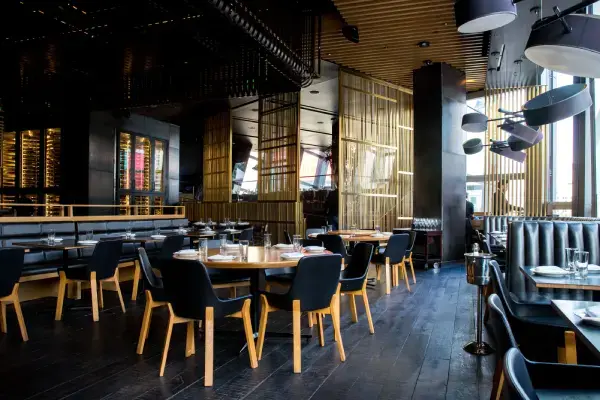Jeff Weinstein credits his career success to, above all, making a lot of mistakes along the way.
“I think people who are successful often have failed quite a lot more than others,” he says. “And that’s a sign of success and resilience.”
Jeff is now the CEO of Vitaligent, a holding company focused on promoting health and happiness in their relationships with guests, team members, and the community. Vitaligent currently owns and operates 92 Jamba franchises and two Cinnabon bakeries. Jeff also serves on the board of Jamba franchise advisory council and on the board of directors of Second Harvest of the Greater Valley. Prior to serving as CEO, Jeff was the president and CEO of Vitaligent and head of operations with Jamba, supporting more than 800 domestic and international locations. His leadership spans roles in operations, category management and specialty sales.
But none of this came naturally to Jeff when he first started in food service three decades ago: in fact, he calls himself a humanities man who didn’t have a footing in the business world at all.
“I’ve learned the business from being in the business and taking it one day at a time,” he says.
In so doing, Jeff slipped up a whole lot—but he was granted the chance to learn from his mistakes and go all the way from dishwasher and cook to CEO. He offers us some of the best practices he’s learned and developed in that process, noting that these apply particularly to organizations that focus on the potential of their team members to grow the company.
Best Practice #1: Create a fail-safe growth environment
The idea of “failing forward” prevails in tech and other innovation-driven industries, where failure is an essential part of growth and experimentation. The attitude is not something people typically associate with QSRs, where consistency reigns. Yet Jeff sees it differently—that a willingness to fail is essential in the restaurant business.
“If you’re coming into an organization, and you're learning how to do something for the first time, whether it's cooking or running a store or running a district, you're going to have to learn a lot of that stuff on the job,” he says. “The environment has got to be a safe one for you to make mistakes. If people come in and they are just scared of making a mistake, they're not going to learn. They're not going to take risks. They're not going to be open to change. And I think we all know how important being willing to make changes, to try some things, is for success.”
He applies this belief not only to hourly workers, but to managers and other leaders—the majority of whom started off as frontline team members.
So how can you create an environment where employees can fail safely—where they can improve both the business and themselves by growing and learning? Two ways:
- Give them both room to fail and a safety net of engagement. “You don't just throw them out there, right? You want to give people really good training and preparation, and then let them know that you're there with them,” Jeff says. “That takes a very high level of engagement. You're giving somebody room to work their plan today or this week. Then you're going to be following up with them tomorrow or next week to debrief on it.”
- Show them safety—don’t just say it. If a team member’s plan didn’t work out so well, you don’t berate them, or restrict them, or negate them in response. Instead, work with them to point out what went well, and what adjustments you both need to make. “I’m going to show you that the mistakes you may have made yesterday are part of the learning process,” Jeff says. “You’re not going to be punished. You’re going to have the opportunity to translate them into a new plan. And once we’re having successes, we’re going to celebrate them together.”
Best Practice #2: Role-model through storytelling
Another way to further develop an environment for safe risk-taking and growth is to go beyond working with team members’ mistakes—to talking through your own.
“One of the best ways to teach people and to role model in our business is through storytelling,” Jeff says. “So I am very open with people about the mistakes that I've made and what the consequences are.”
For instance, he candidly discusses an experience from when he first stepped into becoming a franchisee. He had never selected a new store site before—“And I can tell you that some of those stores haven’t worked out exactly as I expected them to,” he says. “I think we’ve all selected people for our teams, and it turned out those people were not the right fit. I’ll be the first person to tell people about those experiences and what I learned from them.”
A sense of humor helps too, he’s noticed. Being able to laugh about past mistakes and lessons learned goes a long way toward telling the story of your own growth.
“Being vulnerable yourself is a really good way of role-modeling that,” Jeff says. “Then people will feel more comfortable knowing that they can fail sometimes too.”
Best Practice #3: Insist on transparency
Jeff acknowledges that this best practice may not be a cultural fit in every organization, but it’s one he has learned to push to expansive edges: “We have this mindset where we insist on transparency,” he says.
In practice, the way he thinks about that is “not having meetings after the meeting.” Everything is welcome on the table the first time, and managers especially can feel capable of speaking up if Jeff has succeeded in creating and modeling that fail-safe environment.
“I think about it a little bit like siblings,” Jeff says. “I probably argue more with my brother and sister than I do with most people, and we have the most candid conversations. But I’m always going to be first to have their back and defend them. And I think that's a really important team dynamic.”
This way, everybody’s voice gets heard by the entire leadership team. It doesn’t necessarily mean that the organization does what everyone wants—but the team knows it has heard all the ideas and can move forward together.
“At the end of that process, whether you like the decision or not, everyone can rally together and treat that decision like it’s their own,” Jeff says. “We’re all on the same page. That dynamic is important for an organization that relies on teamwork.”
Best Practice #4: Choose confidence over comfort
The difficulty with full transparency, of course, is that those conversations can be really uncomfortable. Speaking up can feel incredibly vulnerable, no matter what someone’s level in the organization is, and the ideas themselves might be challenging.
Yet the team isn’t there to make each other comfortable. “We’re not trying to make them uncomfortable,” Jeff says, “but we would rather that people be confident than comfortable.”
He has found this priority to add real value to Vitaligent and its franchises. The comfort zone (which is entirely distinct from a safe environment) doesn’t encourage growth, or innovation, or risk-taking. It doesn’t push the company to create new value. Jeff connects this back to the first best practice about being willing to fail: if you feel confident, you’ll be more capable of putting yourself out there.
“We think that having confidence in your own voice, confidence in your role, is going to drive leadership success,” Jeff says. “Part of what we’re doing is trying to help people develop, not just so that they can be successful in their roles with us, but that they can be more successful in their lives. It really begins with teaching frontline team members how to make themselves vulnerable, how to put themselves out there. They learn that when they do that, things tend to actually work out better for them than not.”
Best Practice #5: Prioritize people—on both sides of the counter
This final best practice springboards from that attitude of developing your workers: “We’re asking people to be genuine with our guests, right?” Jeff says. “We’ve got to be genuine with our people too.”
He acknowledges right up front that Vitaligent is not a transactional business, unlike other restaurant businesses that prioritize speed of transaction. That’s not a judgment call—just a different business model. But they have come to understand that the guests at their Jamba and Cinnabon franchises care more about feeling acknowledged, recognized and tended to than they care about getting their food fast.
His teams arrived at this understanding by thinking about the business through the lens of what’s best for the guest. “Now, look: when you’re really trying to focus on positive outcomes for people, usually those interests overlap with your interest as a company,” Jeff says. Why not expand this same philosophy to include the team members working at the company?
For him, that means shifting his emphasis from what can team members do for the business to what can the business do for team members. Providing them with extra training and coaching will help them move their careers forward. Adjusting the benefits you’re able to offer so that they can access the ones most important to them will improve their wellbeing outside of work.
The end results might require more up-front investment, but they ultimately improve the company. This is true even when—and Jeff stresses it—what’s best for the team member is to grow beyond your organization.
“You not only have to accept, but you also have to celebrate positive results that might not be in your best interest as an organization,” Jeff acknowledges. “It may be that you’ve prepared somebody for a level of leadership that's now enabling them to go do something outside your organization, and you need to celebrate that. And you need to show everybody in the organization that you’re celebrating that.”
He's gone through this himself recently. A general manager with Vitaligent since the very beginning just moved into another, more specialized industry, with increased pay and more opportunities for his family. Jeff admits to being heartbroken at losing this valuable team member—but it’s even more gratifying that the experience with Vitaligent gave the employee the confidence to pursue this career path.
“That’s one of the rewards of the business,” Jeff says. And he points to some good karma—even beyond the truth that this reputation will entice the best candidates to join the team: “Somewhere down the road, there's a pretty good chance that we'll be working with these people again in the future.”
Final thought: Are you prepared?
Jeff offers five best practices for improving and growing a QSR organization at any scale by focusing on the interpersonal environment:
- Make it safe to fail by demonstrating that mistakes and failures are opportunities to adjust your plans, rather than a cause for retribution.
- Model your own failures as a leader by telling stories about your mistakes and how you learned from them—and maintaining a sense of humor about it all.
- Develop transparency by expecting and allowing all ideas to be spoken aloud—and then deciding as a team which ones to pursue.
- Foster confidence more than comfort, because confidence will spur innovation and growth outside the comfort zone.
- Put people first. Of course a business has to turn a profit to sustain itself. But prioritizing the development of your team members just as much as the customer experience will always improve the business too—even when their successes mean a loss for the company.
But really, Jeff closes with one key piece of wisdom that summarizes them all—and it applies both to experienced restauranteurs assessing their practices, and budding entrepreneurs looking to get into the industry.
“This business is so dependent on people and the relationships you have with people,” he says. “The real best practice is to ask yourself, do you really care about people? And are you really prepared to invest in people?”
Jeff believes both of those things need to be true to succeed in people-centric business. “If you get energy from investing in people,” he says, “then this is a great space for you.”





